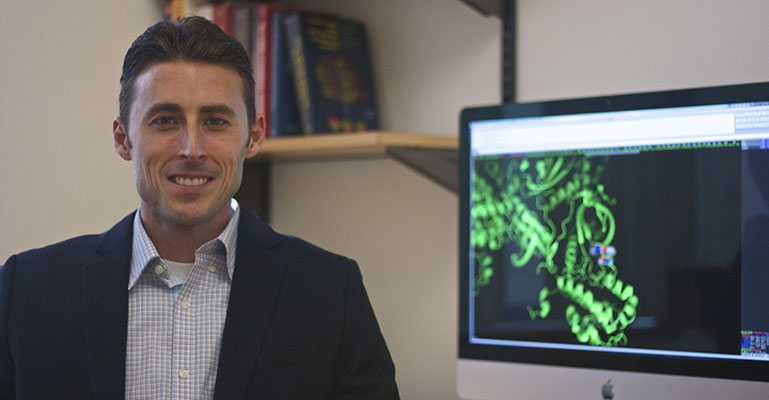The Faculty
Focus
Use of chemoproteomics to characterize and selectively modulate protein‒ligand and protein‒ protein interactions in normal and diseased biological settings.
Biography
University of Arizona, B.S., 2005
Harvard University, Ph.D., 2010
The Scripps Research Institute, Postdoctoral Fellow, 2011-2014
Awards and accolades
Sloan Research Fellow 2020
National Science Foundation CAREER Award 2019
American Cancer Society Research Scholar 2017
NIH Director’s New Innovator Award 2017
Mary Kay Foundation Scholar Award 2016
V Scholar Award, The V Foundation for Cancer Research 2015
CRF Young Investigator Award, The Cancer Research Foundation 2015
NIH Pathway to Independence Award (National Cancer Institute) 2014
Dale F. Frey Award for Breakthrough Scientists, Damon Runyon Cancer Research Foundation 2014
HHMI Postdoctoral Fellowship, Damon Runyon Cancer Research Foundation 2011
Centennial Predoctoral Fellowship, American Association for Cancer Research 2008
Vertex Excellent Graduate Research Award, American Chemical Society 2008
American Chemical Society / Gesellschaft Deutscher Chemiker Scholar Exchange 2007
Research Interests
Who we are: The Moellering Lab is a multi-disciplinary group of scientists with training in chemistry, biochemistry, cell biology and mass spectrometry. We are uniquely situated in both the Department of Chemistry and the Institute for Genomics and Systems Biology at the University of Chicago - thus figuratively and physically bridging the physical and biological sciences.
What we do: Research in the Moellering Lab lies at the interface of chemistry and biology, with an eye towards understanding and intervening in human disease. By integrating chemical synthesis, cell biology and mass spectrometry platforms, our research aims to identify novel biological mechanisms underlying diseases such as diabetes and cancer, and to subsequently develop innovative diagnostic and therapeutic modalities to impact these disorders. We are specifically interested in developing new chemical tools and technologies to study complexity and dynamics in the proteome, thus enabling targeted manipulation of protein targets and the pathways they govern.
Selected publications
Protein Targeting with SAF(er) Electrophiles
Speltz TE & Moellering RE. Nat. Chem.; 2020, 12(10): 885-7. (invited News & Views)
In vivo imaging of the tumor-associated enzyme NCEH1 with a covalent PET probe.
Chang JW, Bhuiyan M, Tsai HM, Zhang HJ, Li G, Fathi S, McCutcheon DC, Leoni L, Freifelder R, Chen CT & Moellering RE. Angew. Chem. Int. Ed.; 2020, accepted online edition.
Interaction profiling methods to map protein and pathway targets of bioactive ligands.
Huang JX, Coukos JS & Moellering RE. Curr. Opin. Chem. Biol.; 2020, 54: 76-84.
Tracking the ties that bind: emerging technologies to capture biomolecular interactions in native environments.
Moellering RE. Curr. Opin. Chem. Biol.; 2020, 54: A1-4.
Photoproximity profiling of protein-protein interactions in cells.
McCutcheon DC, Lee G, Carlos AJ, Montgomery JE & Moellering RE. J. Am. Chem. Soc.; 2020, 142: 146-53.
bioRxiv preprint: https://www.biorxiv.org/content/10.1101/833384v1
Ultrasensitive, multiplexed chemoproteomic profiling with soluble activity-dependent proximity ligation.
Li G, Eckert MA, Chang JW, Montgomery JE, Chryplewicz A, Lengyel E & Moellering RE. Proc. Natl. Acad. Sci. U.S.A.; 2019, 116(43): 21493-500.
Versatile peptide macrocyclization with Diels-Alder cycloadditions.
Montgomery JE, Donnelly J, Fanning S, Speltz T, Shangguan X, Coukos J, Greene G & Moellering RE. J. Am. Chem. Soc., 2019; ASAP.
High throughput discovery of functional protein modifications by hotspot thermal profiling.
Huang JX, Lee G, Cavanaugh KE, Chang JW, Gardel ML & Moellering RE. Nat. Methods, 2019; 16(9): 894-901.
Chemical probes for spatially-resolved measurement of active enzymes in single cells.
Li G & Moellering RE. Methods Enzymol., 2019, online July 12, 2019.
A concise, modular antibody-oligonucleotide conjugation strategy based on disuccinimidyl ester activation chemistry.
Li G & Moellering RE. ChemBioChem, 2019; 20:1599-1605
A metabolite-derived protein modification integrates glycolysis with KEAP1-NRF2 signaling.
Bollong MJ#, Lee G#, Coukos JS, Yun H, Zambaldo C, Chang JW, Chin EN, Ahmad I, Chatterjee AK, Lairson LL, Schultz PG & Moellering RE. Nature, 2018; 562(7728): 600-4.
Chemoproteomic profiling of phosphoaspartate modifications in prokaryotes.
Chang JW, Lee G, Montgomery JE & Moellering RE. Angew. Chem. Int. Ed., 2018; 57(48): 15712-6.
An activity-dependent proximity ligation platform for spatially resolved quantification of active enzymes in single cells.
Li G, Montgomery JE, Eckert MA, Chang JW, Tienda SM, Lengyel E & Moellering RE. Nat. Commun., 2017; 8(1): 1775.
Stapled peptide inhibitors of RAB25 target context-specifc phenotypes in cancer.
Mitra S, Montgomery JE, Kolar MJ, Li G, Jeong KJ, Peng B, Verdine GL, Mills GB & Moellering RE. Nat. Commun., 2017; 8(1): 660.
Profiling reactive metabolites via chemical trapping and targeted mass spectrometry.
Chang JW, Lee G, Coukos JS & Moellering RE. Anal. Chem., 2016; 88 (13): 6658-61




